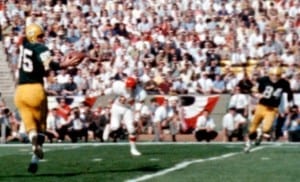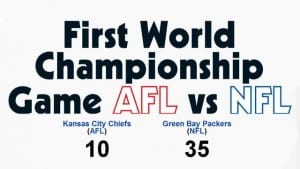
 On Friday, January 15, 2015, the NFL Network will do something that many previously thought was impossible: Rebroadcast the first Super Bowl.
On Friday, January 15, 2015, the NFL Network will do something that many previously thought was impossible: Rebroadcast the first Super Bowl.
The legend of the first Super Bowl has been known for some time. It was (and in many ways still is) lost to history. All known copies of the game were either destroyed or had deteriorated before they could be preserved. Clips and parts of the game survived, but the full game seemed to be lost to the sands of time.
However, in 2005, a nearly complete video of the game surfaced. A Virginia man whose father had recorded the tapes on a stable format not only had the game on tape, but had it well-preserved.
But when he tried to take the tape public, he ran into a myriad of problems between copyright law and an uncooperative NFL that kept the take in the dark.
Instead, the NFL has opted to piece together the game from available clips and it claims to have found all 145 play and are piecing it together to create a complete game. Combined with new commentary and packaging, what the NFL Network will air on Friday may be Super Bowl 1, but it won’t be the game as those in 1967 experienced it.
To understand this, we have to look at just how this game was lost, then found and then lost again.
The History of Super Bowl 1
 On January 15, 1967, in Los Angeles Memorial Coliseum, the National Football League’s (NFL) Green Bay Packers and the American Football League’s (AFL) Kansas City Chiefs squared off to settle a rivalry between the two leagues and play in then known as the First AFL-NFL World Championship Game, a title that would be retroactively changed to Super Bowl 1.
On January 15, 1967, in Los Angeles Memorial Coliseum, the National Football League’s (NFL) Green Bay Packers and the American Football League’s (AFL) Kansas City Chiefs squared off to settle a rivalry between the two leagues and play in then known as the First AFL-NFL World Championship Game, a title that would be retroactively changed to Super Bowl 1.
It was a largely uneventful game with Green Bay making short work of Kansas City, winning the game 35-10 in front of a stadium littered with empty seats. Instead of big names like The Who, Slash, The Black Eyed Peas or Madonna, the Grambling Marching Band teamed up with the University of Arizona Symphonic Marching Band to put on the halftime show.
One thing the game did get was plenty of TV coverage. Since the NFL and AFL were separate leagues (they had begun to merge but wouldn’t become two conferences in the same league until 1970), the two leagues had separate TV contracts. CBS Held the NFL broadcast rights and NBC held the AFL rights. Due to that, both stations simulcast the game, shooting it out to a combined 51 million viewers.
However, all of that coverage did not save it from being lost. Tapes of both the NBC and CBS broadcast were lost over the years. By the 2000s, the lack of a complete tape of the game had become widely known and, in 2005, Sport Illustrated listed it as one of the “lost treasures” of sports.
It was at that point that a man named Steve Harwood came forward, claiming to have a nearly-complete copy of the game.
The Last (Known) Surviving Tape
Following the Sports Illustrated article, a Virginia man named Steve Harwood came forward and claimed that he had a copy of the game, namely of the CBS broadcast.
According to Harwood, his father had recorded the game using a videotape machine at his work. Harwood claims he did so in hopes that the tape would become valuable and, with it being the last surviving copy, Harwood’s father seemed to have been right.
Upon learning how sought after it was, Harwood immediately took the tape to the Paley Center for Media in New York for preservation and restoration. There, they restored the tape, bringing it back to its former glory and
The tape, to be clear, isn’t 100% complete. It doesn’t include the halftime show and portions of the third quarter are missing. However, of a game where only clips and short portions had been known to survive, it was an amazing discovery and a piece of sports history.
However, it was to be a piece of sports history that no one would be able to enjoy, at least not yet.
Copyright and the NFL
After realizing the value in the tape, Harwood immediately sought to sell it and approached the NFL. However, the NFL was less than interested in the broadcast.
According to his lawyer, Harwood claimed the tapes were valued at more than $1 million but the NFL responded by offering only $30,000. However, the NFL also shut down any hopes of selling it to a 3rd party saying that doing so would prompt a copyright infringement lawsuit from them.
The reason is fairly straightforward, the recording was an unauthorized reproduction of the broadcast, which the NFL still held the copyright to. While it wasn’t illegal to record the broadcast, time-shifting is legal in the United States (even for nearly 50 years), selling it would be a copyright infringement.
Imagine, for a moment, that this were any other broadcast. Instead of the first Super Bowl, Harwood’s father had recorded a popular Hollywood film or a season of a TV show and then tried to sell those copies, it would be a clear copyright infringement.
The result put Harwood in a difficult position. He had a (legal) product of great value but it only had one potential legal buyer: The NFL. However the NFL wasn’t making offers that he felt were reasonable and the two parties reached an impasse that remains in effect today.
In short, Harwood owns the physical tape but the NFL owns the copyright, without the two sides working together, the tape won’t be seen by anyone other than Harwood himself and his friends/ and family.
Because of this, even after more than a decade post-discovery, Super Bowl 1 remains largely unwatchable by the public.
The Super Bowl Turns 50
With the fiftieth Super Bowl due to be played this February, the NFL, understandably, wants to commemorate and honor the game that started it all. However, the only known surviving copy was in the hands of someone who they were unable to strike a deal with.
Instead of paying Harwood for the tape, the NFL, according to its press releases, has opted to go a different approach. By combining clips and parts of the game they have from available recordings, the NFL claims that they were able to stitch together the entire game including all 145 plays and much of the postgame video.
However, the league admits that watching that content without modern help will be difficult on viewers so they are adding new content to the video to ensure viewers are aware of what’s going on and can follow it correctly.
So while the broadcast will likely be the completely game, it also likely won’t be anything like what those who viewed it in 1967 experienced.
How fans will react to that will have to be seen.
Bottom Line
All in all, there’s not really a bad guy here. Harwood has a legitimate copy of something that’s a great value and he wishes to profit from it. However, copyright law, in a legitimate effort to stem potential abuse of time shifting, makes that illegal. The one person he can sell it to, the NFL, has little motivation to pay a premium because, due to the law, they’re the only potential buyer.
While we could wait for the copyright in the tape to expire, a process that could take 45 years, the best hope we have for seeing the tape in the near term is that the NFL and Harwood will work out an arrangement.
However, if a deal couldn’t be struck for the 50th Super Bowl, it’s unlikely one will be reached on the 51st. All we can do is wait and see what happens and hope that the two sides are able to work something out.
Want to Reuse or Republish this Content?
If you want to feature this article in your site, classroom or elsewhere, just let us know! We usually grant permission within 24 hours.